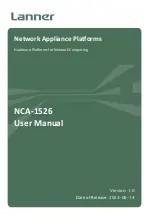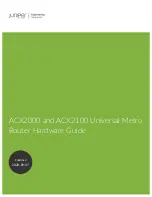
Glossary
CyberSWITCH 100 Advanced User Information 57
Local Area Network (LAN) —
A network connecting computers over a relatively small
geographic area (usually within a single campus or building).
MAC Layer/Address —
Media Access Control layer/address defined by the IEEE 802.3
specification which defines media access including framing and error detection. Part of the OSI
reference model Data Link layer.
Metric —
An algorithm used by routers to determine the best path for transmitting packets to a
remote destination based on considerations such as time, delay, cost, etc.
Modem —
Modulator/Demodulator. A device that converts digital signals to/from analog signals
for transmission over analog communications lines.
Multi-Link Protocol —
A protocol, defined in RFC 1717, that defines a way to perform inverse
multiplexing on the TCP/IP point-to-point protocol (PPP); i.e., the ability to use multiple serial
WAN channels for transferring one datastream. With MLP, a user can send and receive data over
both B channels in an ISDN basic-rate interface connection
NetWare —
A Network Operating System developed by Novell, Inc. providing shared access to
files and other network services.
Network Layer —
Layer 3 of the OSI reference model that provides the protocol
routing function.
Node —
Refers to a termination point for communication links; entity that can access a network.
OSI —
Open System Interconnection. An international standard developed by ITU (formally
CCITT) and ISO (International Organization for Standardization) to facilitate data networking
multi-vendor interoperability. The OSI Reference Model defines seven layers, each providing
specific network functions.
Packet —
A group of data that includes a header and usually user data for transmission through a
network.
Ping (Packet Internet Groper) —
An echo message, available within the TCP/IP protocol suite,
sent to a remote node and returned; used to test the accessibility of the remote node.
PPP (Point-to-Point Protocol) —
A Data Link layer protocol that provides asynchronous and
synchronous connectivity between computer/network nodes. Includes standardization for security
and compression negotiation.
Summary of Contents for CyberSWITCH CSX101
Page 1: ...CyberSWITCH 100 FAMILY INFORMATION PWR LAN LINE CH1 CH2 NT1 P N 9031944 01 September 1997 ...
Page 2: ......
Page 4: ...Notice ii CyberSWITCH 100 Advanced User Information VCCI Notice ...
Page 12: ...Preface x CyberSWITCH 100 Advanced User Information ...
Page 20: ...ISDN Line Ordering and Configuration 8 CyberSWITCH 100 Advanced User Information ...
Page 34: ...About the CyberSWITCH 100 Router 22 CyberSWITCH 100 Advanced User Information ...
Page 50: ...Planning Your Router s Configuration 38 CyberSWITCH 100 Advanced User Information ...
Page 64: ...Troubleshooting 52 CyberSWITCH 100 Advanced User Information ...
Page 66: ...Hardware Specifications 54 CyberSWITCH 100 Advanced User Information ...
Page 72: ...Glossary 60 CyberSWITCH 100 Advanced User Information ...




































